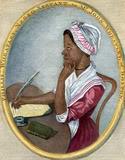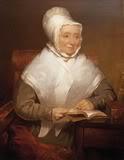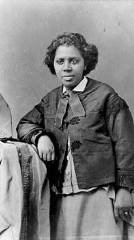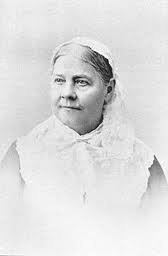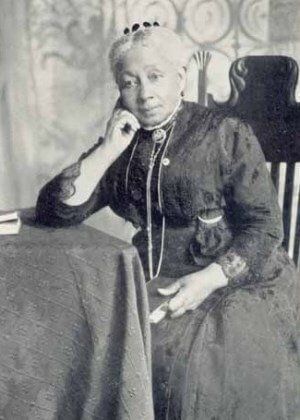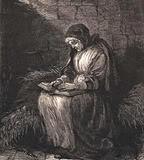America’s First Black Poet
Phillis Wheatley was born circa 1753 in West Africa, and was very likely kidnapped into slavery. She was named for the slave ship, Phillis, that brought her to Boston on July 11, 1761. She was purchased as a personal slave to Susannah Wheatley, wife of tailor John Wheatley, a prominent Boston merchant with a wholesale business, real estate, warehouses, and the schooner London Packet. Phillis was evidently around 7 years old at the time, and took her new master’s surname.
A frail child, Phillis was chosen to be a domestic servant and companion to Susannah Wheatley, an ardent Christian, in her later years. Although she spoke no English upon her arrival in this country, Phillis soon proved to be a precocious learner, and was tutored by the Wheatley’s daughter Mary in English, Latin, history, geography, religion, and the Bible. Young Phillis quickly learned to speak English and to read the Bible with amazing fluency.
Phillis was treated more as a member of the family than a servant or slave, and her education was the same as that of a young woman in an elite Boston family. She was particularly well-acquainted with the classics and contemporary works, especially those of Alexander Pope, and these influences are readily apparent in her writing.
Because of her poor health, obvious intelligence, and Susannah Wheatley’s fondness for her, Phillis was never trained as a domestic servant. The Wheatley family allowed Phillis time to study and write. As early as 1765, she was writing poetry. Her first published poem, “On Messrs Hussey and Coffin,” appeared in 1767 in the Newport Mercury.
In 1765, when Phillis Wheatley was eleven years old, she wrote a letter to Reverend Samson Occum, a Mohegan Indian and an ordained Presbyterian minister. Despite the difference in their ages (Occum was born in 1723), Phillis’ letter apparently led to a friendship with Occum, who was also a poet, and who later published an Indian hymnal.
In 1770, Phillis’ elegy on the death of George Whitefield, a celebrated evangelical Methodist minister who had traveled through the American colonies, drew international attention and the interest of Selina Hastings, the Countess of Huntingdon.
By 1771, Phillis had composed enough verse to fill a volume, but she couldn’t find an American publisher. With the Countess of Huntingdon’s help, a London publisher was found and plans for the publication had begun. She sailed for England in mid-1773, accompanied by the Wheatleys’ son Nathaniel.
In London, Phillis was entertained by various dignitaries, including Benjamin Franklin. The London reception was followed by the release of her book, Poems on Various Subjects, Religious and Moral, making her the first African American, the first slave and the third woman in the United States to publish a book of poetry. This gave her an international reputation, but her fame was short-lived.
Phillis was called home by the illness of Susannah Wheatley, and departed before the book appeared in September. While she met many notables in London, she was unable to see the Countess of Huntingdon, who was away in Wales for the summer.
When a London publisher later presented the manuscript of Phillis Wheatley’s Poems on Various Subjects to the Countess of Huntingdon, the antislavery English noblewoman was reportedly “fond of having the book dedicated to her; but one thing she desired [was]…to have Phillis’ picture in the frontispiece.”
The man commissioned to draw the likeness of Phillis was Scipio Moorhead, an enslaved African in service to Reverend John Moorhead, a neighbor and friend of the Wheatley family and pastor of the Church of the Presbyterian Strangers. Reverend Moorhead, along with fifteen other prominent Massachusetts citizens, had signed a testimonial that prefaced the manuscript.
Scipio Moorhead not only painted portraits, but wrote verse as well. His artistic talents had been nurtured by the Reverend’s wife, Sarah Moorhead, a teacher of art and drawing. His drawing of Phillis, said to be a fine likeness, was shipped to England to be engraved. When the book was published, it contained a poem, To S.M. a young African Painter, on seeing his Works, in which she praised the artist and voiced her hopes that their collaboration would lead to his fame.
The 1773 publication of Phillis Wheatley’s Poems on Various Subjects established her as a young prodigy and challenged the major justification for enslavement of Africans – the European assumption of African inferiority.
In the 18th century, Europeans generally assumed that Africans lacked the intellectual capacity for such pursuits as creative writing and mathematics; consequently, Phillis’ book was prefaced by testimonies to its authenticity from her master and from sixteen of Boston’s most respected citizens, thereby establishing a literary convention for works by African Americans in the 18th and 19th centuries. Despite such testimonials, Thomas Jefferson was among those who questioned its authorship.
One of the best-known poems in the collection is dedicated To the Right Honourable William, Earl of Dartmouth, His Majesty’s Principal Secretary of State for North-America. Phillis was heartened by the appointment of Dartmouth, whom she had met in London and knew to be a friend of the abolitionist Countess of Huntingdon and of the late Reverend George Whitefield.
The poem opens with hopeful optimism that under Dartmouth’s “blissful sway,” the colonies will see “Freedom’s charms unfold” and experience an end to the reign of “wanton Tyranny” that “meant t’enslave the land.” Those lines provide a subtle yet powerful segue into the next verse, in which she proposes that her “love of Freedom” (and by implication, that of the black Patriots) springs from the anguish Africans have known as slaves.
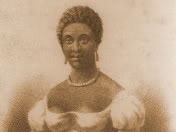
Image: Portrait of Phillis Wheatley
Shortly after her return to Boston, Phillis was freed by her master, and Susannah Wheatley died in March of 1774.
On February 11, 1774, Phillis wrote to Reverend Samson Occum again, to comment on an indictment of slave-holding Christian ministers that he had written. She strongly concurred with the argument put forth by Occum, writing that she was “greatly satisfied with your Reasons representing the Negroes” and thought “highly reasonable what you offer in Vindication of their natural Rights.”
While she implored God’s deliverance from “those whose Avarice impels them…” she hastened to add, “This I desire not for their Hurt, but to convince them of the strange Absurdity of their Conduct whose Words and Actions are so diametrically opposite.”
As she did in several of her poems, Phillis used the letter to Occum as an occasion to point out the contradiction between the colonists’ demands for freedom from Britain and their determination to uphold slavery. She wrote, “How well the Cry for Liberty, and the reverse Disposition for the Exercise of oppressive Power over others agree – I humbly think it does not require the Penetration of a Philosopher to determine.”
In 1778, Phillis married John Peters, a free black Bostonian, and gave birth to three children, two of whom died in infancy. Abandoned by her husband and plagued by ill health, she lived in poverty during the last years of her life.
She continued to write, even while working as a domestic servant and caring for her children. She drew up proposals for a second volume of poetry and letters which was never published, possibly due to wartime shortages in Boston. Her final manuscript was never found.
By 1784, Phillis Wheatley was living in a boardinghouse, and, in December of that year, she and her remaining child died and were buried in an unmarked grave. She was thirty-one.
Two volumes of her work were published posthumously: Memoir and Poems of Phillis Wheatley (1834) and Letters of Phillis Wheatley, the Negro Slave-Poet of Boston (1864).
SOURCES
Brooklyn Museum
Africans in America
Phillis Wheatley Biography
Letter to Reverend Samson Occum
To the Right Honourable William, Earl of Dartmouth
African Americans and the End of Slavery in Massachusetts
